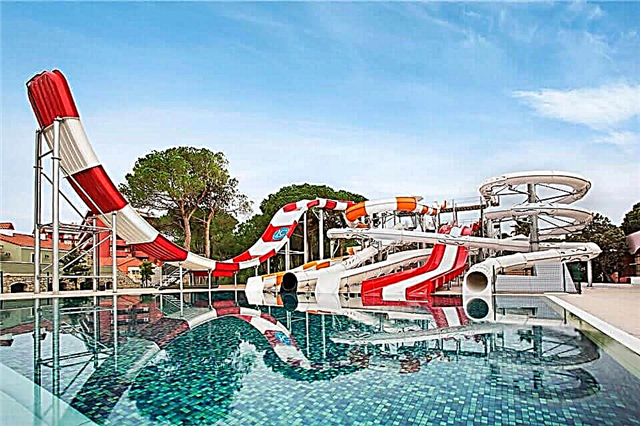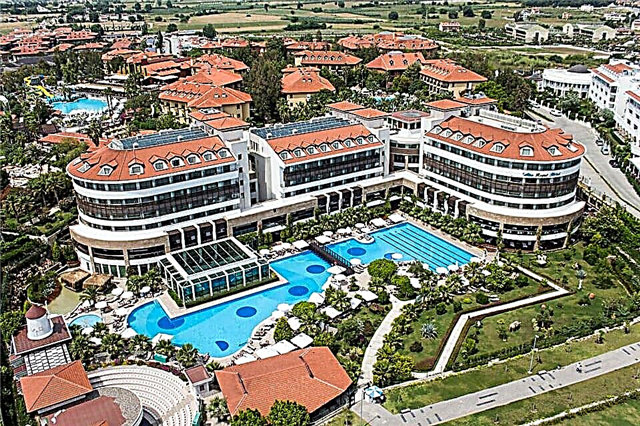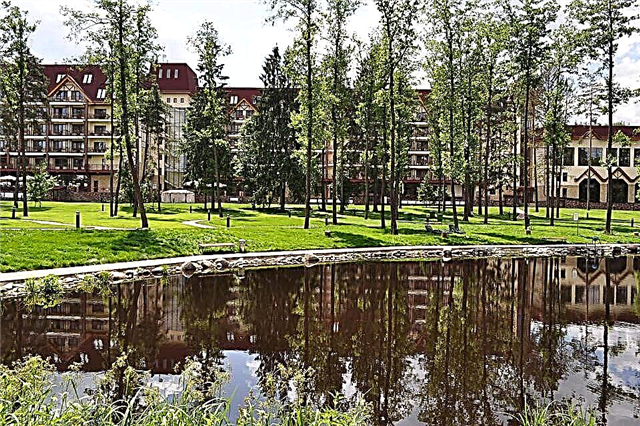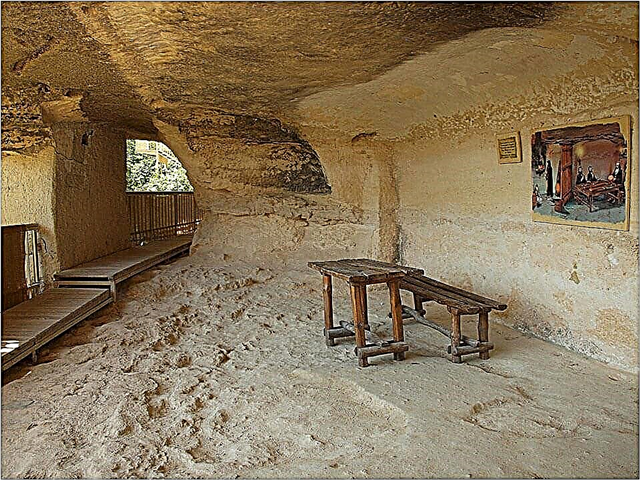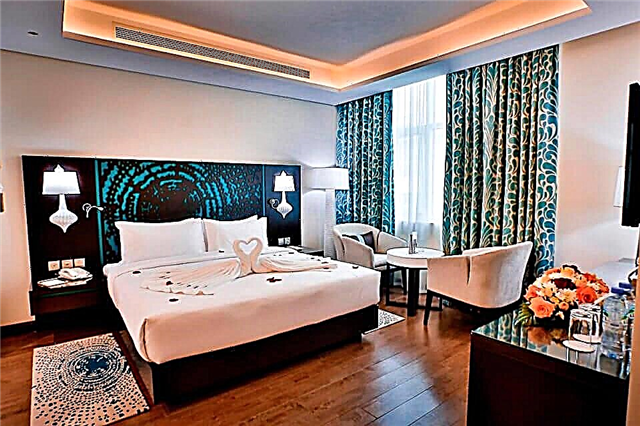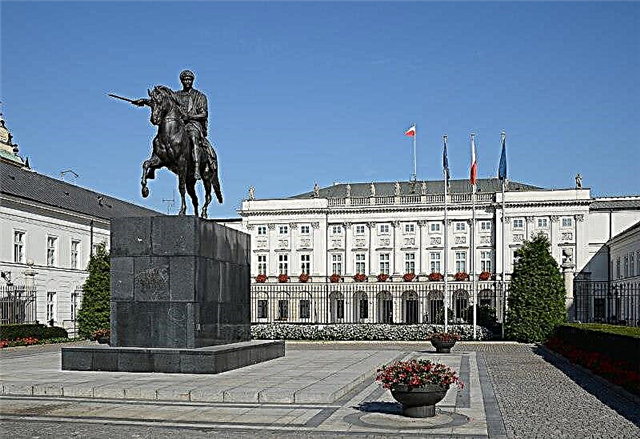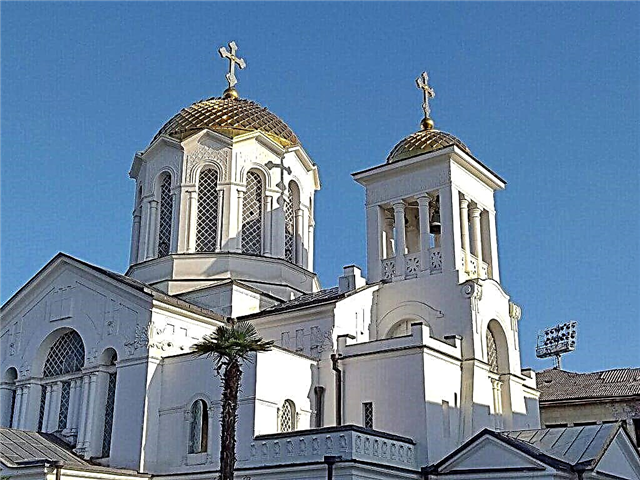A small country in the southeast of the Black Sea coast in the language of the indigenous people - the Abkhaz is called Apsny. This word is translated as "the country of the soul." It is difficult to argue with such a name. This is confirmed by the numerous temples of Abkhazia. A stay against the backdrop of the amazing beauty of nature, relaxation on pebble beaches is a holiday for the soul.
It is impossible not to admire the picturesque mountains that occupy 70% of the territory. The famous Lake Ritsa, the New Athos cave, the Dombai-Ugleya mountain and others are known all over the world. It is not without reason that there is a legend about the origin of the country: God gave the Abkhaz the place that he left for himself. The indispensable objects of visiting by tourists are the ancient temples of Abkhazia.
Pitsunda temple

The Cathedral of St. Andrew the First-Called located on the territory of the Great Pitiunt reserve in the center of Pitsunda is the brightest monument of Christianity. It was erected in the 4th century AD. NS. in honor of the holy apostle who preached the faith of Christ in the 1st century A.D. He is considered the founder of the Abkhaz Church along with Simon Kananit. Their relics rest in the cathedral tomb.
The Patriarchal Cathedral (its other name) received its present appearance in the 10th century. The magnificent structure impresses with its mighty architecture, reminiscent of a fortress. The thick walls, built of wild stone and brick, are impressive in power. At the bottom of the building there is a tomb painted with amazing frescoes.
In 1975 the cathedral was converted into a concert hall. Icons, mosaics, crosses were taken to the Tbilisi Museum. A rare German-made organ with a unique sound was installed in the room. Crowds of people come here to see the cathedral, the ruins of other ancient buildings and listen to organ music. Medieval paintings have been preserved inside the sanctuary; the dome is decorated with a fresco with the face of Christ.
Visitors climb up, sitting on small balconies, from which the stage with the organ is clearly visible. The sound is so strong that the vibrations crumble paint from the frescoes. Now the question of transferring the instrument to another place is being decided in order to preserve the valuable paintings.
Church of the Assumption of the Blessed Virgin

A recognized masterpiece of architecture that embodies the Christian religion. The only one in the country that has retained its authentic look. A unique building of the 10th century is located in the village. Lykhny, in the Lykhnashty glade. The past millennium has practically not affected the church, but in order to avoid damage, the religious monument has now been protected from the rain by a canopy.
It is valuable as an example of the North Caucasian church, which was built by Abkhaz architects by order of the bishops. In the era of planting in the country of paganism, he remained Orthodox, being under the protection of the princes Shervashidze. One of the prince's sons is buried in the church. After 10 years of oblivion (1820-30), when the Russian army entered the village, the church began to function again.
The architecture of the church building is interesting. It looks like a cross-domed cathedral, but unlike other structures of this type, it has a small dome diameter, narrow oil and transept. Also unusual are 2 annexes, from the west and from the south, a kind of synthesis of a vestibule and a portico. Today this object is actively visited by tourists and residents of the republic.
One cannot help but be amazed at the millennial walls that have stood for 1000 years. They are lined with hewn limestone and bricks. The rich painting (14th century) covering the interior walls is amazing. The image of the Mother of God with the baby in her arms is expressive, surrounded by 2 angels (in the center of the viper). Angels and saints, Jesus Christ, Abraham, John the Baptist, etc. are talentedly depicted.
New Athos Simon-Cananite Monastery

The world famous landmark, religious complex and pilgrimage site - the monastery is located on Mount Athos. It was created by Greek monks in 1875 and named after the Apostle Simon the Canaanite. He was killed as a preacher of Christianity in the 1st century. n. Roman legionnaires. The place where Simon lived in a small cave is revered as a saint.
The construction of the monastery was completely completed at the beginning of the 20th century. Over the years, a whole complex of religious buildings with a well-equipped territory has been created. Paved pavements, a pier, park alleys have appeared, approaches and entrances to the object have been decorated.
In total, 6 churches have been built here, among which the Panteleimon Cathedral dominates. This is a true architectural gem among other sanctuaries. Erected in 1900 in honor of Saint Panteleimon, it is made in the neo-Byzantine style. Its 5 domes stand proudly, the highest of them (40 m) is the central one.
The path of sinners leads to the cathedral, passing which one is freed from sins. The interior design is unusually beautiful: frescoes, icons are real works of art. Along the perimeter of the quadrangle, there are 5 other churches: the Ascension of the Lord, Andrew the First-Called, the Martyr Jerome, the Monk Fathers of Athos and the Mother of God the Redeemer.
Blagoveshchensky cathedral
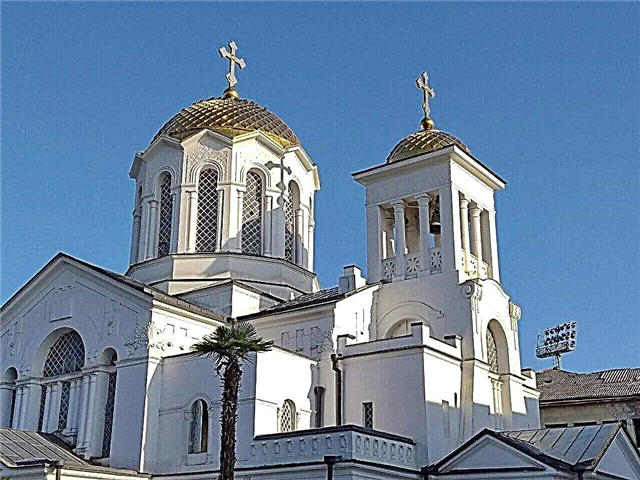
The architectural decoration of the center of Sukhum - the Annunciation Cathedral attracts attention with its graceful lines and beauty. Its shining dome with a cross is clearly visible from the sea. It was erected in 1909 by Greek monks in honor of St. Nicholas. Later it became known as Blagoveshchensky, acquiring the status of the Cathedral of the Sukhum-Abkhaz diocese.
Abkhazian metropolitans are staying here today, clerics are ordained. Built in neo-Byzantine style, the white building looks great after renovation in 2010. A new dome was installed using the most modern technologies.
The cells of the dome are made of stainless steel coated with a nitrotitanium layer imitating gilding. Unique Orthodox shrines are kept inside. Parishioners worship icon-painting images of saints, including Andrew the First-Called, John Chrysostom, and others.
There is a true rarity here - the icon of Panteleimon with the relics of the holy healer. Until 1990, the ashes of John Chrysostom were kept in the cathedral, which was later transferred to the Kaman temple. The parishioners especially venerate the icon-painting faces of St. Simon the Canaanite, the Iberian Mother of God. In commemoration of Nicholas the Wonderworker, services are held in the chapel named after him. There is a Sunday school at the cathedral.
Abaata

A popular tourist site is located in Gagra, on the territory of the seaside park. This is the ancient Abaata fortress (4-5 c), built by the Abkhaz as a defensive structure. It was repeatedly damaged and rebuilt. For two centuries (14-15 c) the fortress was owned by the Genoese, who founded the Kakara (Gagra) trading post.
Currently, the medieval monument continues to decay. The wall facing the sea is almost completely destroyed by storms. The area is used today by businessmen to attract tourists. A hotel, shops, a restaurant are built here.
The well-preserved Christian Church of the Intercession of the Most Holy Theotokos (Abaata) is the center of attention for tourists and locals. It is one of the oldest monuments in the country and is under the patronage of non-canonical Orthodoxy. All divine services and ceremonies take place here.
Outwardly, the building looks modest and simple, its architecture is devoid of any excesses. The Bolnisi cross, a symbol of the 5th century Georgian style, is carved on the western façade made of limestone slabs. There are no rich paintings and decorations inside, but this does not detract from the dignity of an authentic monument.
Temple of Simon the Canaanite

The great interest of tourists in New Athos (Anakopia in ancient times) is a monument of church architecture of the 10th century - the Church of Simon the Canaanite. It was here that the preacher of Christianity settled after wandering in the middle of the 1st century, here he was executed by the Romans.At the place of his burial, preserved in the memory of the believers, later a temple was built in his honor.
After the official recognition of Orthodoxy, the Church of Simon the Canaanite became the religious center of the Anakopian diocese. The construction of the Greek type, laid out of wild stone, was destroyed and rebuilt more than once. In 1875-82. the church underwent a thorough restoration by the monks.
The last reconstruction of the building after a period of oblivion took place in 1956. The wall frescoes were partially restored. It is currently open to visitors. Divine services, weddings, baptisms are taking place. Simon the Cananite is reputed to be the patron saint of family happiness and marriage. Hundreds of pilgrims rush under its vaults on May 23 (the saint's birthday).
They take part in the procession, ask for well-being and love in the family. On the walls of the shrine, 2 inscriptions in Greek have been preserved - one above the southern portico, the second on the eastern facade. They are listed as ethnographic monuments. Graceful supports, arches, vaults, expressive plastic of the walls give the church a magnificent view.
Tsandripshsky temple

A unique monument of antiquity (5-6 c) - one of the first sanctuaries is located in the village. Tsandripsh. In the Byzantine era, this village was the capital of Sanigia, a state that was later annexed to Abkhazia. The structure, hidden in dense thickets, is of great interest to specialists and lovers of antiquity. The complex architecture of the basilica with many arches, side naves, and an apse does not allow us to accurately define the style and find its analogue.
Dense thickets of palms, cypresses, bushes surround the gray ruins. Despite numerous destruction, the mighty arched walls make an indelible impression. The apse, altar niche, south wall and chapel are well preserved here. Only fragments remain of the semicircular vault. The remains of the once powerful columns are visible in front of the central entrance.
The central element of the 3-part apse looks good. The fragments of the northern side-altar can be used to reconstruct its full view. Remnants of the interior walls showcase the splendor of the interiors. Today the altar is separated by a wooden partition for preservation. Services are occasionally held here. The majestic remains of a rare building simply scream for restoration.
Ilor temple
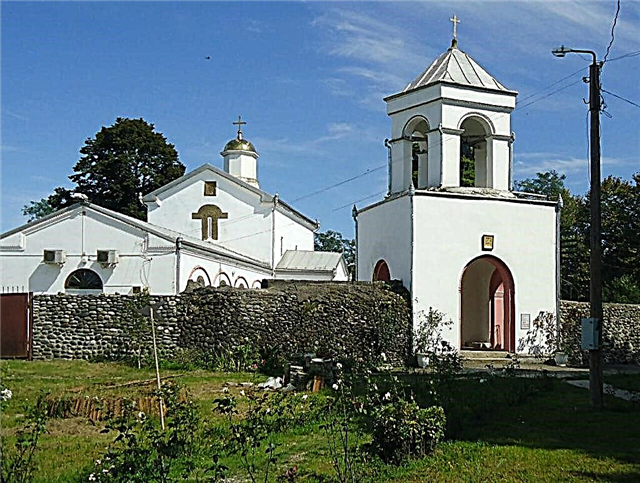
A popular religious site among believers is located in Ilora, a small village. Built in the XI century. and bears the name of George the Victorious. From the moment of its construction, it was known as an example of rich interior decoration. Containers for the liturgy made of gold and silver, a golden throne bowl, a silver folding sword, forged icons with silver frames were kept in a luxurious sacristy.
One of the silver icons depicting George of Ilor is considered miraculous. Pilgrims and missionaries from different countries came here to worship her. According to the parishioners, the icon of Eustathius of Apsilsky, who was tortured in the Arab city of Haran (738), also has miraculous power.
In the 19th century, an iron roof was made in a dilapidated church, the walls were covered with a layer of plaster. The craftsmen have preserved all the bas-reliefs and inscriptions on the facade walls, recreated an authentic cobblestone fence. After the Soviet period of closure, the church regained its former grandeur, enjoying the extraordinary popularity of believers and tourists.
Every year, on St. George's Day (October 21), with a large gathering of people, a solemn liturgy is organized here. The external beauty of the snow-white building cannot but amaze.
Anakopia temple

Anyone who visits the Iverskaya Mountain at least once can touch the ancient history, feel the breath of the distant past in the present. It is located in the vicinity of New Athos. But the mountain itself is not so interesting for travelers, but the old Anakopia fortress is the first center of Christianity in the country.
The citadel was erected on the top of the mountain in the 4th century at an altitude of 345 m above sea level and was named Anakopia. Behind the powerful stone walls there were 2 towers, a siege well and an Anakopia temple. It was dedicated to the great martyr Theodore Tiron. At one time he was famous for the miraculous image of the Most Holy Theotokos. There is a legend about the icon, which tells of its miraculous appearance in the fortress.
The religious site is built on an elevation in the center of the territory. It is composed of limestone blocks and large pebbles, interspersed with bricks. Window niches are finished with the latter. The church has almost completely lost its original appearance as a result of repeated rebuilding. The altar niche in the form of a wide apse is well preserved.
Here are kept limestone slabs with Greek inscriptions and images of cypresses, fish, crosses, symbolizing early Christianity. These fragments were removed from the walls of the building. The facts captured in medieval manuscripts testify to the miracles of healing given by the image of the Most Holy Theotokos. Today, many visitors come here to inspect the noble ruins.
Bedia Cathedral

The small village of Agu-Bedia is widely known not only throughout Abkhazia, but also beyond its borders. The ancient Bedia temple built during the reign of the Abkhazian king Bagrat III (999) made it famous. The place he chose among the mountains made the cathedral and the surrounding buildings a reliable citadel. On the day of the opening of the sanctuary, the king and queen mother presented a golden cup (chalice) to the temple.
Today, a valuable vessel and a wonderful piece of jewelry are kept in the Tbilisi Art Museum. The cross-domed structure was consecrated in honor of the Blakherna Icon of the Mother of God (today the north-west of Istanbul). Currently, the image of the patroness of the Byzantine emperors is kept in the Assumption Cathedral in Moscow.
Bedia Cathedral was built in the Byzantine style, its architecture embodied the features of other monuments of Christianity of that era. The massive walls are made of rough gray stone. The internal space is divided into 3 rooms: the central hall and 2 side ones, separated from it by an arched colonnade. Only a few fragments remain of the wall paintings.
The western wall is decorated with the image of the Byzantine emperor Constantine as the protector of Christians. Bedia Cathedral was in operation until the Ottoman invasion in the early 17th century. For almost 2 centuries, it was abandoned and underwent restoration at the end of the 18th century. Its facades and dome were renewed. Near the religious monument, you can see the ruins of the episcopal palace - an object of sightseeing by tourists.


